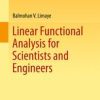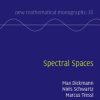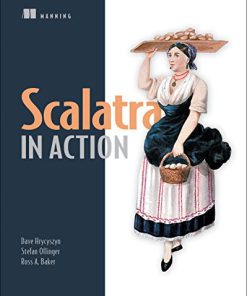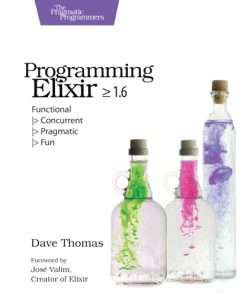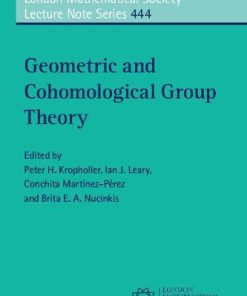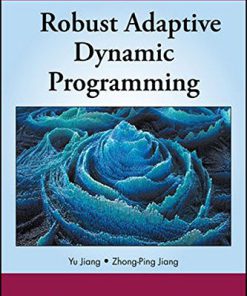Robust and Error Free Geometric Computing 1st Edition by Dave Eberly ISBN 9781000056624 1000056627
$50.00 Original price was: $50.00.$25.00Current price is: $25.00.
Robust and Error Free Geometric Computing 1st Edition by Dave Eberly – Ebook PDF Instant Download/Delivery: 9781000056624 ,1000056627
Full download Robust and Error Free Geometric Computing 1st Edition after payment
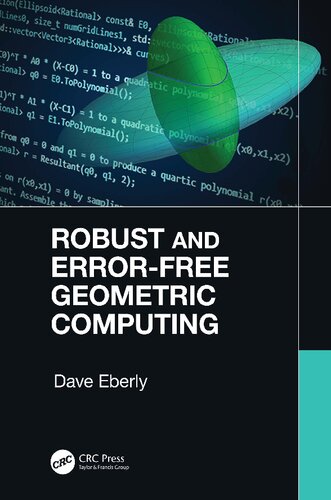
Product details:
ISBN 10: 1000056627
ISBN 13: 9781000056624
Author: Dave Eberly
Robust and Error Free Geometric Computing 1st Edition Table of contents:
1 Introduction
1.1 Eigendecomposition for 3 × 3 Symmetric Matrices
1.1.1 Computing the Eigenvalues
1.1.2 Computing the Eigenvectors
1.1.3 A Nonrobust Floating-Point Implementation
1.1.4 A Robust Floating-Point Implementation
1.1.4.1 Computing the Eigenvalues
1.1.4.2 Computing the Eigenvectors
1.1.5 An Error-Free Implementation
1.2 Distance between Line Segments
1.2.1 Nonparallel Segments
1.2.2 Parallel Segments
1.2.3 A Nonrobust Floating-Point Implementation
1.2.4 A Robust Floating-Point Implementation
1.2.4.1 Conjugate Gradient Method
1.2.4.2 Constrained Conjugate Gradient Method
1.2.5 An Error-Free Implementation
2 Floating-Point Arithmetic
2.1 Binary Encodings
2.2 Binary Encoding of 32-bit Floating-Point Numbers
2.3 Binary Encoding of 64-bit Floating-Point Numbers
2.4 Rounding of Floating-Point Numbers
2.4.1 Round to Nearest with Ties to Even
2.4.2 Round to Nearest with Ties to Away
2.4.3 Round toward Zero
2.4.4 Round toward Positive
2.4.5 Round toward Negative
2.4.6 Rounding Support in C++
3 Arbitrary-Precision Arithmetic
3.1 Binary Scientific Notation
3.2 Binary Scientific Numbers
3.2.1 Addition
3.2.2 Subtraction
3.2.3 Multiplication
3.3 Binary Scientific Rationals
3.3.1 Addition and Subtraction
3.3.2 Multiplication and Division
3.4 Conversions
3.4.1 Floating-Point Number to BSNumber
3.4.2 BSNumber to Floating-Point Number
3.4.3 BSRational to BSNumber of Specified Precision
3.4.4 BSNumber to BSNumber of Specified Precision
3.5 Performance Considerations
3.5.1 Static Computation of Maximum Precision
3.5.1.1 Addition and Subtraction
3.5.1.2 Multiplication
3.5.2 Dynamic Computation of Maximum Precision
3.5.3 Memory Management
4 Interval Arithmetic
4.1 Arithmetic Operations
4.2 Signs of Determinants
4.3 Primal Queries
4.3.1 Queries in 2D
4.3.2 Queries in 3D
5 Quadratic-Field Arithmetic
5.1 Sources of Rounding Errors
5.1.1 Rounding Errors when Normalizing Vectors
5.1.2 Errors in Roots to Quadratic Equations
5.1.3 Intersection of Line and Cone Frustum
5.2 Real Quadratic Fields
5.2.1 Arithmetic Operations
5.2.2 Allowing for Non-Square-Free d
5.2.3 Allowing for Rational d
5.3 Comparisons of Quadratic Field Numbers
5.4 Quadratic Fields with Multiple Square Roots
5.4.1 Arithmetic Operations
5.4.2 Composition of Quadratic Fields
5.5 Estimating a Quadratic Field Number
5.5.1 Estimating a Rational Number
5.5.2 Estimating the Square Root of a Rational Number
5.5.3 Estimating a 1-Root Quadratic Field Number
5.5.4 Estimating a 2-Root Quadratic Field Number
5.5.4.1 Two Nonzero Radical Coefficients
5.5.4.2 Three Nonzero Radical Coefficients
6 Numerical Methods
6.1 Root Finding
6.1.1 Function Evaluation
6.1.2 Bisection
6.1.3 Newton’s Method
6.1.4 Hybrid Newton-Bisection Method
6.1.5 Arbitrary-Precision Newton’s Method
6.2 Polynomial Root Finding
6.2.1 Discriminants
6.2.2 Preprocessing the Polynomials
6.2.3 Quadratic Polynomial
6.2.4 Cubic Polynomial
6.2.4.1 Nonsimple Real Roots
6.2.4.2 One Simple Real Root
6.2.4.3 Three Simple Real Roots
6.2.5 Quartic Polynomial
6.2.5.1 Processing the Root Zero
6.2.5.2 The Biquadratic Case
6.2.5.3 Multiplicity Vector (3, 1, 0, 0)
6.2.5.4 Multiplicity Vector (2, 2, 0, 0)
6.2.5.5 Multiplicity Vector (2, 1, 1, 0)
6.2.5.6 Multiplicity Vector (1, 1, 1, 1)
6.2.6 High-Degree Polynomials
6.2.6.1 Bounding Root Sequences by Derivatives
6.2.6.2 Bounding Roots by Sturm Sequences
6.2.6.3 Root Counting by Descartes’ Rule of Signs
6.2.6.4 Real-Root Isolation
6.3 Linear Algebra
6.3.1 Systems of Linear Equations
6.3.2 Eigendecomposition for 2 × 2 Symmetric Matrices
6.3.3 Eigendecomposition for 3 × 3 Symmetric Matrices
6.3.4 3D Rotation Matrices with Rational Elements
7 Distance Queries
7.1 Introduction
7.1.1 The Quadratic Programming Problem
7.1.2 The Linear Complementarity Problem
7.1.3 The Convex Quadratic Programming Problem
7.1.3.1 Eliminating Unconstrained Variables
7.1.3.2 Reduction for Equality Constraints
7.2 Lemke’s Method
7.2.1 Terms and Framework
7.2.2 LCP with a Unique Solution
7.2.3 LCP with Infinitely Many Solutions
7.2.4 LCP with No Solution
7.2.5 LCP with a Cycle
7.2.6 Avoiding Cycles when Constant Terms are Zero
7.3 Formulating a Geometric Query as a CQP
7.3.1 Distance Between Oriented Boxes
7.3.2 Test-Intersection of Triangle and Cylinder
7.4 Implementation Details
7.4.1 The LCP Solver
7.4.2 Distance Between Oriented Boxes in 3D
7.4.3 Test-Intersection of Triangle and Cylinder in 3D
7.4.4 Accuracy Problems with Floating-Point Arithmetic
7.4.5 Dealing with Vector Normalization
8 Intersection Queries
8.1 Method of Separating Axes
8.1.1 Separation by Projection onto a Line
8.1.2 Separation of Convex Polygons in 2D
8.1.3 Separation of Convex Polyhedra in 3D
8.1.4 Separation of Convex Polygons in 3D
8.1.5 Separation of Moving Convex Objects
8.1.6 Contact Set for Moving Convex Objects
8.2 Triangles Moving with Constant Linear Velocity
8.2.1 Two Moving Triangles in 2D
8.2.2 Two Moving Triangles in 3D
8.3 Linear Component and Sphere
8.3.1 Test-Intersection Queries
8.3.1.1 Line and Sphere
8.3.1.2 Ray and Sphere
8.3.1.3 Segment and Sphere
8.3.2 Find-Intersection Queries
8.3.2.1 Line and Sphere
8.3.2.2 Ray and Sphere
8.3.2.3 Segment and Sphere
8.4 Linear Component and Box
8.4.1 Test-Intersection Queries
8.4.1.1 Lines and Boxes
8.4.1.2 Rays and Boxes
8.4.1.3 Segments and Boxes
8.4.2 Find-Intersection Queries
8.4.2.1 Liang–Barsky Clipping
8.4.2.2 Lines and Boxes
8.4.2.3 Rays and Boxes
8.4.2.4 Segments and Boxes
8.5 Line and Cone
8.5.1 Definition of Cones
8.5.2 Practical Matters for Representing Infinity
8.5.3 Definition of a Line, Ray and Segment
8.5.4 Intersection with a Line
8.5.4.1 Case c2 ≠ 0
8.5.4.2 Case c2 = 0 and c1 ≠ 0
8.5.4.3 Case c2 = 0 and c1 = 0
8.5.5 Clamping to the Cone Height Range
8.5.6 Pseudocode for Error-Free Arithmetic
8.5.6.1 Intersection of Intervals
8.5.6.2 Line-Cone Query
8.5.7 Intersection with a Ray
8.5.8 Intersection with a Segment
8.5.9 Implementation using Quadratic-Field Arithmetic
8.6 Intersection of Ellipses
8.6.1 Ellipse Representations
8.6.1.1 The Standard Form for an Ellipse
8.6.1.2 Conversion to a Quadratic Equation
8.6.2 Test-Intersection Query for Ellipses
8.6.3 Find-Intersection Query for Ellipses
8.6.3.1 Case d4 ≠ 0 and e(x̄) ≠ 0
8.6.3.2 Case d4 ≠ 0 and e(x̄) = 0
8.6.3.3 Case d4 = 0, d2 ≠ 0 and e2 ≠ 0
8.6.3.4 Case d4 = 0, d2 ≠ 0 and e2 = 0
8.6.3.5 Case d4 = 0 and d2 = 0
8.7 Intersection of Ellipsoids
8.7.1 Ellipsoid Representations
8.7.1.1 The Standard Form for an Ellipsoid
8.7.1.2 Conversion to a Quadratic Equation
8.7.2 Test-Intersection Query for Ellipsoids
8.7.3 Find-Intersection Query for Ellipsoids
8.7.3.1 Two Spheres
8.7.3.2 Sphere-Ellipsoid: 3-Zero Center
8.7.3.3 Sphere-Ellipsoid: 2-Zero Center
8.7.3.4 Sphere-Ellipsoid: 1-Zero Center
8.7.3.5 Sphere-Ellipsoid: No-Zero Center
8.7.3.6 Reduction to a Sphere-Ellipsoid Query
9 Computational Geometry Algorithms
9.1 Convex Hull of Points in 2D
9.1.1 Incremental Construction
9.1.2 Divide-and-Conquer Method
9.2 Convex Hull of Points in 3D
9.2.1 Incremental Construction
9.2.2 Divide-and-Conquer Method
9.3 Delaunay Triangulation
9.3.1 Incremental Construction
9.3.1.1 Inserting Points
9.3.1.2 Linear Walks and Intrinsic Dimension
9.3.1.3 The Insertion Step
9.3.2 Construction by Convex Hull
9.4 Minimum-Area Circle of Points
9.5 Minimum-Volume Sphere of Points
9.6 Minimum-Area Rectangle of Points
9.6.1 The Exhaustive Search Algorithm
9.6.2 The Rotating Calipers Algorithm
9.6.2.1 Computing the Initial Rectangle
9.6.2.2 Updating the Rectangle
9.6.2.3 Distinct Supporting Vertices
9.6.2.4 Duplicate Supporting Vertices
9.6.2.5 Multiple Polygon Edges of Minimum Angle
9.6.2.6 The General Update Step
9.6.3 A Robust Implementation
9.6.3.1 Avoiding Normalization
9.6.3.2 Indirect Comparisons of Angles
9.6.3.3 Updating the Support Information
9.6.3.4 Conversion to a Floating-Point Rectangle
9.7 Minimum-Volume Box of Points
9.7.1 Processing Hull Faces
9.7.1.1 Comparing Areas
9.7.1.2 Comparing Volumes
9.7.1.3 Comparing Angles
9.7.2 Processing Hull Edges
9.7.3 Conversion to a Floating-Point Box
Bibliography
Index
People also search for Robust and Error Free Geometric Computing 1st Edition:
robust and error free geometric computing pdf
robust and error-free geometric computing
robust and error-free geometric computing pdf
software robustness
Tags:
Dave Eberly,Robust,Error Free,Geometric Computing
You may also like…
Computers - Programming
Scalatra in Action First Edition by Dave Hrycyszyn 1617291293 9781617291296
Computers - Programming
Mathematics - Symmetry and group
Geometric Group Theory An Introduction 1st Edition Clara Löh
Engineering - Engineering - General & Miscellaneous
Mathematics - Symmetry and group
Geometric and Cohomological Group Theory 1st Edition Peter H. Kropholler
Education Studies & Teaching
Mathematics - Geometry and Topology
Geometric Inequalities Methods of Proving 1st Edition by Hayk Sedrakyan 3319550799 9783319550794
Politics & Philosophy - Anthropology


